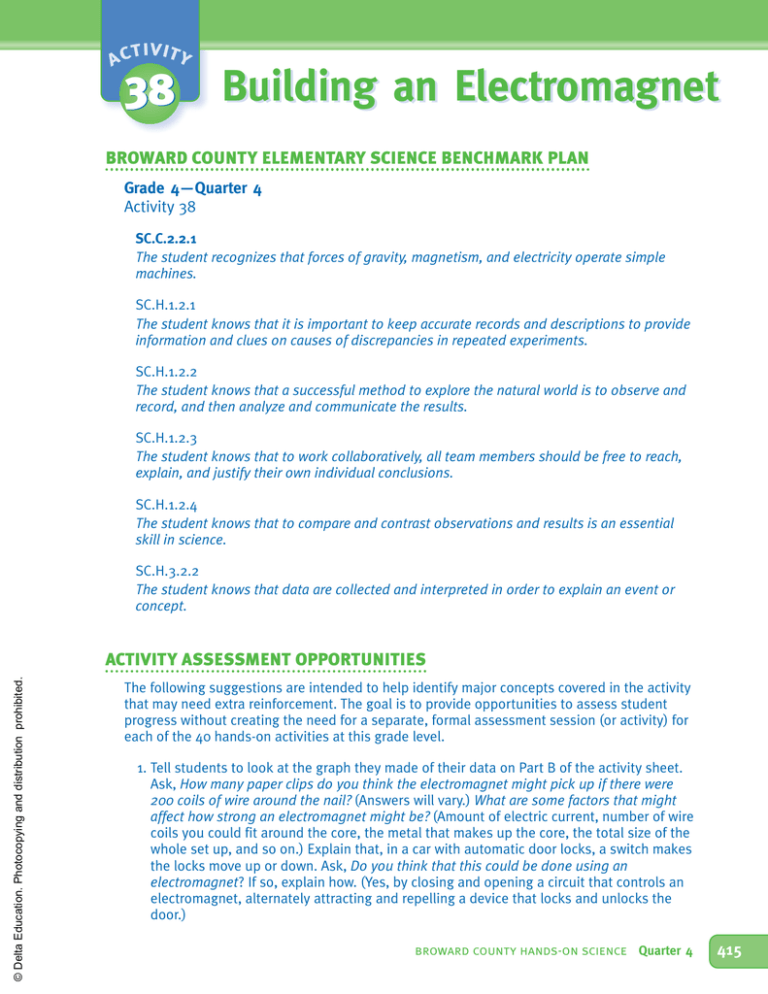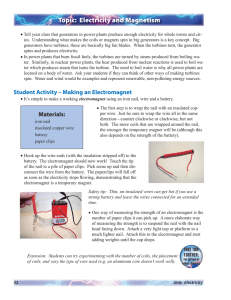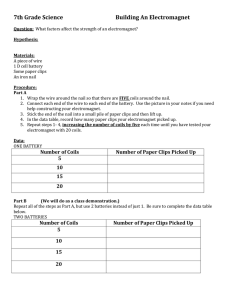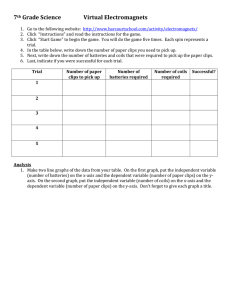38. Building an Electromagnet
advertisement

iv act ity 38 Building an Electromagnet BROWARD COUNTY ELEMENTARY SCIENCE BENCHMARK PLAN Grade 4—Quarter 4 Activity 38 SC.C.2.2.1 The student recognizes that forces of gravity, magnetism, and electricity operate simple machines. SC.H.1.2.1 The student knows that it is important to keep accurate records and descriptions to provide information and clues on causes of discrepancies in repeated experiments. SC.H.1.2.2 The student knows that a successful method to explore the natural world is to observe and record, and then analyze and communicate the results. SC.H.1.2.3 The student knows that to work collaboratively, all team members should be free to reach, explain, and justify their own individual conclusions. SC.H.1.2.4 The student knows that to compare and contrast observations and results is an essential skill in science. SC.H.3.2.2 The student knows that data are collected and interpreted in order to explain an event or concept. © Delta Education. Photocopying and distribution prohibited. ACTIVITY ASSESSMENT OPPORTUNITIES The following suggestions are intended to help identify major concepts covered in the activity that may need extra reinforcement. The goal is to provide opportunities to assess student progress without creating the need for a separate, formal assessment session (or activity) for each of the 40 hands-on activities at this grade level. 1. Tell students to look at the graph they made of their data on Part B of the activity sheet. Ask, How many paper clips do you think the electromagnet might pick up if there were 200 coils of wire around the nail? (Answers will vary.) What are some factors that might affect how strong an electromagnet might be? (Amount of electric current, number of wire coils you could fit around the core, the metal that makes up the core, the total size of the whole set up, and so on.) Explain that, in a car with automatic door locks, a switch makes the locks move up or down. Ask, Do you think that this could be done using an electromagnet? If so, explain how. (Yes, by closing and opening a circuit that controls an electromagnet, alternately attracting and repelling a device that locks and unlocks the door.) broward county hands-on science Quarter 4 415 2. Use the Activity Sheet(s) to assess student understanding of the major concepts in the activity. 416 activity 38 Building an Electromagnet © Delta Education. Photocopying and distribution prohibited. In addition to the above assessment suggestions, the questions in bold and tasks that students perform throughout the activity provide opportunities to identify areas that may require additional review before proceeding further with the activity. iv act ity 38 Building an Electromagnet OBJECTIVES In this activity, students build an electromagnet that can pick up objects. The students construct and use an electromagnet alter one variable at a time to determine the relative strength of an electromagnet record and graph data obtained from their experiments with electromagnetism For the class 1 pair wire cutters 1 roll wire, enamel-coated *provided by the teacher PREPARATION 1 Make one copy of Activity Sheet 38, Parts A–C, for each student. 2 Cut one 2.25-m (7.5-ft) length of enamelcoated wire for each team of four. About 1 cm (0.5 in.) of the enamel coating should be removed from each end by lightly sanding the ends with a piece of emery cloth. (If you decide to strip the enamel coating off the wire yourself, do so now. Otherwise, instruct the students to do it when they build the electromagnet.) 3 Each team will also need a nail, two rubber rings, twenty-five paper clips, a piece of emery cloth, three D-cell batteries, six electrical clips, a Circuitworks base, two 15-cm (6-in.) pieces of plastic-insulated wire with stripped ends, and a metric ruler. SCHEDULE About 1 hour VOCABULARY electromagnet energy series circuit MATERIALS © Delta Education. Photocopying and distribution prohibited. For each student 1 Activity Sheet 38, Parts A–C 1 pair safety goggles* For each team of four 3 1 6 1 pc 1 25 2 1 2 pcs batteries, D-cell Delta CircuitworksTM base electrical clips emery cloth nail paper clips rings, rubber ruler, metric wire, plastic-insulated, 15-cm BACKGROUND INFORMATION An electromagnet is created when electric current flows through coils of wire that are wrapped around a ferrous object. An iron nail is not normally a magnet because the random arrangement of its atoms cancels out any net magnetic properties. However, when electric current flows through a coil of wire that is wrapped around the nail, the domains of the nail become aligned, creating an electromagnetic field around the nail. broward county hands-on science Quarter 4 417 The strength of an electromagnet can be increased in two ways: Activity Sheet 38, Part B Building an Electromagnet Record your data in the chart below. 1. Increasing the amount of current flowing through the wires. Number of Paper Clips Picked Up Number of Wire Coils Numbers will vary but should increase with coils of wire. 2. Increasing the number of coils of wire wrapped around the ferrous object. Make a line graph of your data. Remember to add a title to your graph. Number of Paper Clips Picked Up Number of Coils and Strength of Electromagnet Graph should reflect data in chart. Number of Wire Coils Activity Sheet 38, Part A Activity Sheet 38, Part C Building an Electromagnet Building an Electromagnet 1. Follow these steps to build an electromagnet. a. Push one end of the enamel-coated wire through a rubber ring. Push the tip of the nail through the rubber ring. b. Slide the ring toward the head of the nail. Pull about 25 cm of wire from under the ring. c. Wrap ten turns of wire neatly around the shank of the nail. Be careful not to overlap the wires. d. Add a second rubber ring to the long end of the wire. Slide the ring over the tip of the nail to hold the wraps on. The ring should be about 2 cm from the tip of the nail. Do not worry about the extra wire. It will be used later. Record your data in the chart below. Number of Batteries 1 2 3 Number of Paper Clips Picked Up Numbers will vary but should increase with number of magnets. Make a line graph of your data. Remember to add a title to your graph. Note: Do not leave the wires connected to the battery for longer than 20–30 seconds at a time. That will make the battery get weaker. How many clips were you able to pick up? Where is the electromagnet the strongest? Answers will vary. at the ends of the nail 2. Wrap more coils of wire around the nail and try picking up more paper clips. Remember to remove the rubber ring and add coils. Then replace and adjust the rubber ring to keep 2 cm of nail left at the tip. Record and graph your results on Part B of the activity sheet. Stop when you have one hundred coils. 3. Look at the chart in Part C. Record the number of paper clips your electromagnet (with one hundred coils of wire and one battery) picked up. Add another battery to the circuit. Record the number of paper clips you can pick up. Add a third battery to the circuit. Record the number of paper clips you can pick up. Safety Note: As the number of batteries is increased, the wire and the nail may become hot soon after the circuit is connected. If the wire becomes too hot to touch, disconnect the circuit. 418 activity 38 Building an Electromagnet Number of Batteries 4. Which factors affected the strength of your electromagnet (the number of paper clips it was able to pick up)? the number of coils of wire on the nail and the number of batteries in the circuit © Delta Education. Photocopying and distribution prohibited. e. Connect each end of the wire to a battery. Try to pick up paper clips with your electromagnet. Number of Paper Clips Picked Up Number of Batteries and Strength of Electromagnet Guiding the Activity 1 Distribute one copy of Activity Sheet 38, Parts A, B, and C, to each student. Discuss the directions for building an electromagnet. Distribute the materials to each team of four. 2 Write the word electromagnet on the board. Tell students that they will now create a temporary magnet, using a nail in combination with an electric circuit. © Delta Education. Photocopying and distribution prohibited. After the students have completed step 1 on Part A of Activity Sheet 38, ask, Why do you think this system (the iron nail, coils of wire, and a battery) becomes an electromagnet? (See Figure 38-1 for setup.) Additional Information This magnet is called an electromagnet because its magnetic field is produced by electricity. Students should infer that the electric current flowing through the wire coils induces a magnetic field in the nail. If students are having difficulty stating this concept, have them disconnect one end of the wire from the battery and see that when current stops flowing, the nail is no longer magnetized. Figure 38-1. An electromagnet. broward county hands-on science Quarter 4 419 Guiding the Activity 3 4 Additional Information Ask, How were you able to tell that the nail was magnetized? Students should mention that the end of the magnetized nail attracted paper clips. Ask students to complete steps 2 and 3 on Part A of the activity sheet. They will record their data on Parts B and C of the activity sheet. If they have difficulty graphing their data, help them number both axes of each graph and then show them how to graph the first set of data points on their chart. In step 2, students record the number of paper clips they can pick up as they increase the number of coils wrapped around the nail. In step 3, students record the number of paper clips they can pick up as they increase the number of batteries. As needed, supervise the teams as they add two more batteries to the Circuitworks base. Use two electrical clips to secure each battery to the base, making sure the terminals line up in the same direction (+/–, +/–, +/–). Connect the batteries in a series with the 15-cm insulated wires. A circuit such as the ones students set up in this activity is called a series circuit. In a series circuit, the current flows through all the devices in a single path. An interruption at any point along the path breaks the circuit. Ask, Using just the tip of the nail, how many paper clips can you pick up with your electromagnet? The number of paper clips that can be picked up will vary depending on the number of batteries in the circuit and the number of coils on the nail. 420 Ask, Does adding paper clips to one end of the nail affect the other end of the nail? No. The magnetic strength is the same at either end of the nail, regardless of the number of paper clips already attached. If the nail is removed from the coil, will the coil alone pick up paper clips? No. The nail is an essential part of the electromagnet. What would happen to the strength of the electromagnet if the coils of wire were spread out more? Nothing would happen, as long as the number of coils on the nail remained the same. activity 38 Building an Electromagnet © Delta Education. Photocopying and distribution prohibited. Note: It is important that students push together—or spread out—the coils around the nail so that the amount of nail tip that is exposed past the rubber ring (it should be approximately 2 cm) is the same each time they attempt to pick up paper clips. The only variables in this activity should be the number of coils and the number of batteries. Guiding the Activity What factors affect the strength of an electromagnet? REINFORCEMENT Invite students to magnetize a nail by rubbing it in one direction with a magnet, and then try to pick up paper clips with it. Next have them coil a piece of wire around another nail, connect the ends of the wire to a battery, then try to pick up paper clips with the tip of the nail. Tell them to compare the number of paper clips they can pick up with each nail. Assessment Opportunity This Reinforcement also may be used as an ongoing assessment of students’ understanding of science concepts and skills. Additional Information The more turns of wire wrapped around the nail, the stronger the electromagnet is. The greater the number of batteries attached to the circuit, the stronger the electromagnet is. CLEANUP The circuits should be disconnected and the materials removed from the Circuitworks bases. SCIENCE AT HOME How does your doorbell work? Wire is wound around a spring-loaded ferrous plunger. When the doorbell button is pushed, current flows through the coil, pulling the plunger down and causing it to hit one of the bells—Ding! When the button is released, the plunger springs back, hitting the second bell—Dong! DING DONG! SCIENCE JOURNALS © Delta Education. Photocopying and distribution prohibited. Have students place their completed activity sheets in their science journals. broward county hands-on science Quarter 4 421 Connections Science Challenge Then stroke the iron-filled tube thirty times in one direction with one end of a bar magnet. Try to pick up paper clips again. Has the iron-filled tube become a magnet? (yes) How many paper clips does it pick up and hold? Shake the tube several times and try to pick up paper clips with it again. How many clips will it pick up and hold now? Challenge students to determine whether an electromagnet has north and south poles. Tell them to use the electromagnet that they made and any other materials of their choice. Allow students to experiment freely for a period of time with minimum guidance. An electromagnet does have north and south poles. Students can discover this by slowly moving a compass toward one end of the electromagnet. If the colored end of the needle swings toward it, that end of the electromagnet is its south end. If the noncolored end swings toward it, that end of the electromagnet is its north end. Students can verify their results by using the compass to test the other end of the electromagnet. When the tube is no longer magnetic, coil wire around it and attach the wires to a battery. Try to pick up paper clips with the tube. Does it function as an electromagnet? (yes) Disconnect the wires from the battery and shake the tube, then reconnect the wires to the battery. Test the tube with paper clips again. What happens? (The tube is again magnetized.) Ask students to explain what happened. (The tube lost its magnetism when the current was disconnected but regained it when the current was reconnected.) Science Extension 422 Have students magnetize a nail by stroking it repeatedly in one direction with one end of a magnet, then try to pick up paper clips with the magnetized nail. Did the nail become magnetized? If it did not, it should be stroked for a longer period of time. Now, ask students to strike the nail against a hard object (such as the wire cutters) and to see if they can pick up the same number of paper clips. What happens? (The nail should lose its magnetism.) Now, ask students to predict what would happen if they reversed the wire connections on the battery. Let them test their predictions. When the connections are reversed, the poles of the electromagnet also are reversed. When the connections are reversed, the electric current flows in the opposite direction, which reverses the electromagnet’s poles. Have students work in small groups to make a magnet with iron filings. Fill a test tube with iron filings, and push the cork in tightly. Try to pick up paper clips with the filled tube to see whether it is magnetic. activity 38 Building an Electromagnet Science, Technology, and Society Have students brainstorm applications for electromagnets—magnets that can be turned on and off by connecting and disconnecting an electric current. For example, students may have seen pictures of large crane-mounted electromagnets used to pick up, move, and then release scrap metal in a junkyard. Ask students what they would need to add to the electromagnet they made to make it easier to turn on and off. Ask students to make a switch for their electromagnet. If possible, arrange for a class visit to a scrap-metal processing center so students can see a crane-mounted electromagnet in use. © Delta Education. Photocopying and distribution prohibited.








